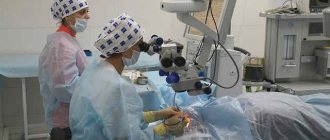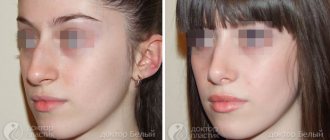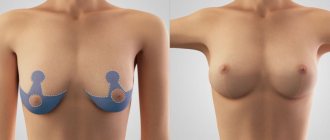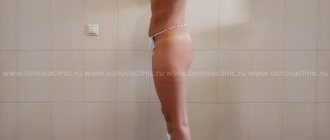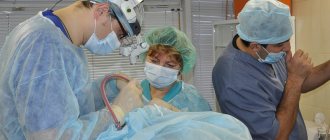The operation will help tighten the skin on the lower and upper eyelids simultaneously, eliminating all age-related or congenital problems associated with sagging skin of the upper eyelids or the formation of bags under the eyes.
Comprehensive correction of the upper and lower eyelids will help restore a youthful and expressive look.
Circumferential blepharoplasty is an inexpensive and quick solution to problems around the eyes, regardless of whether these are age-related changes or genetic predisposition.
Who is suitable for circumferential blepharoplasty?
Circular blepharoplasty can eliminate congenital or acquired pathologies of the periorbital eye area in one go. Indications for it are:
- Sagging and drooping corners of the eyes due to aging
- Ptosis of soft tissues in the area of the upper and lower eyelids simultaneously
- Deep expression lines and folds around the eyes
- Acquired defects
- Bags and swelling under the eyes along with sagging of the upper eyelid
- Fat hernias
- Another indication may be a congenital predisposition to sagging eyelid skin at an early age or dissatisfaction with appearance without medical indications.
What does NOT help with sagging and drooping upper eyelids?
On the Internet you can find information that sagging upper eyelids can be eliminated with the help of simple and harmless procedures, but in fact they do not give the desired effect, since they do not solve the main problems of skin reduction or a lifting effect that can solve the problem.
⚡ Search engines are not familiar with anatomy and the problems of aging, as are the authors of such illiterate articles. No cream, no self-massage will help reduce or move the skin flap of the upper eyelid!⚡
Rating of useless procedures:
- RF lifting (a course of procedures affects the skin, stimulating collagen and elastin, but does not help in the fight against drooping eyelids)
- Microcurrents (the procedure is focused on tissue restoration, does not provide any lifting or reduction of the skin)
- Plasma therapy (plasma injections help to activate the processes of restoration and rejuvenation in the skin; they are useless for ptosis)
- “Cold plasma” - hardware targeted plasma treatment (a very dangerous innovation in cosmetology, we have not recorded any positive results)
- Biorevitalization, mesotherapy, bioreparation
- Home massages , masks and creams.
Don't fall for loud advertising slogans!
Preparing for surgery
When preparing for circumferential blepharoplasty, pay close attention to all the recommendations of the plastic surgeon. So:
- Start undergoing examinations and tests no earlier than 2 weeks before the scheduled date of the operation.
- It is recommended to stop drinking alcohol 2-3 weeks before surgery, as well as avoid smoking tobacco.
- 2 weeks before surgery you should stop taking medications that affect blood clotting.
- 1 day before the operation, wash your hair and take a bath, since after the operation this will only be possible in a couple of days.
- 8 hours before surgery it is important to follow a “starvation diet”
- Avoid drinking liquids 5 hours before.
Surgical facelift cost in Moscow at the Doctor Grishkyan clinic
Facial plastic surgery in Moscow, cost of surgery
| Operation name | Cost in rubles |
| SMAS SMAS face and neck lift with shortened scar and vertical axis of tension (MACS-LIFT STANDART method) | 400000 350 000 |
| SMAS SMAS face and neck lift with a shortened scar and a vertical axis of tension (MACS-LIFT ADVANCED method) and correction of the midface and jowl area | 500000 |
Forehead and eyebrow plastic surgery cost
| Operation name | Cost in rubles |
| Temporal lift | 180000 |
Neck plastic surgery, platysmoplasty surgery cost
| Operation name | Cost in rubles |
| Plastic surgery of the central part of the neck | 150000 |
See all prices
How is circumferential blepharoplasty performed?
The combination of upper and lower blepharoplasty is considered a rather complex surgical procedure, requiring the surgeon to have the proper experience and qualifications.
The time of the operation depends on the extent of the surgical intervention and the individual characteristics of the patient. On average, the procedure takes from 1.5 to 3 hours. The essence of this technique is to combine classical upper eyelid surgery and the transconjunctival method of lower blepharoplasty, but depending on the indications, these methods can vary for the best result. The surgeon can also use laser correction of the upper eyelid or the classic method of lifting the lower eyelid.
On video: A fragment from the operating room at the time of performing circular blepharoplasty on a 45-year-old male patient. The use of laser equipment makes the surgeon’s work easier, and in some cases it is simply irreplaceable.
Depending on the chosen method, the incisions for lower blepharoplasty are made either along the growth of the ciliary row or along the inner side of the mucous membrane of the eyelid. In the case of upper blepharoplasty, the incision will be made in the natural crease of the eyelid so that the seam will not be visible in the future. Through the incisions, fat packets are removed or redistributed, excess skin is excised, and soft tissue is tightened and secured with a cosmetic suture.
Methods that help solve the problem
In addition to surgery (upper blepharoplasty), there are only 2-3 effective methods that relatively work (only!) for stages 1 and 2 of ptosis of the upper eyelid.
Botulinum therapy - lifting effect in the initial manifestations of the problem
Complex botulinum therapy of the upper third of the face (injections of Xeomin, Botox, Dysport) in the hands of an experienced cosmetologist can provide lifting of the edges of the eyebrows - the so-called “flying eyebrows”. Often, novice cosmetologists get this effect when the drug is incorrectly adjusted.
The correct effect of raised eyebrows ensures smoothing of overhanging skin above the eyes.
On the left is the state before BTA therapy, on the right is the result of lifting.
This method can solve the problem of sagging only with a slight excess of skin.
Floated halves of eyebrows do not look natural, so patients often ask to rid themselves of this “devil's eyebrows” effect.
“Eyebrows of Mephistopheles” in life.
⚡ Cost of botulinum therapy: 6000 - 10000 rubles (depending on the number of toxin units).
An additional beauty of the procedure is that at the same time you will get rid of facial wrinkles on the forehead and around the eyes!
Thread lifting of the upper eyebrow area
One of the most popular methods, which (this is important!) does not help with significant sagging of the upper eyelid.
Photo from the portal irecommend.ru
The essence of the method is approximately the same as with botulinum therapy - it involves lifting the skin and subcutaneous tissues of the lateral edges of the eyebrows upward using threads with notches and fixing this position.
The procedure, when in addition to the upper eyebrow area the corner of the eye is also tightened, is called “fox eyes” on the Internet - it does not remove the overhang of the upper eyelid, since the upper eyelid itself is also pulled up.
⚡ Cost : when performing a thread lift, 6-10 short threads with notches are usually used, the cost of one thread ranges from 500 to 1200 rubles, depending on the manufacturer.
It is important to understand! The temporal area in which the lifting is carried out does not have dense tissues for which threads with notches can be securely attached. That is why one or two threads are not enough. That is why the result of the manipulations is short-lived - only 3-4 months.
After 3 months, the threads dissolve and the eyelid area returns to its original state.
Often after correction (even after 1-2 months), a visual trace of the procedure remains: the threads “contour” . The reason for this is precisely the insufficient volume of soft tissue: feel above your eyebrow - under the skin there is a small layer of fat and immediately the skull. There is simply nowhere for the threads to hold on and “hide”!
Thread lifting is a relatively inexpensive way to solve the problem of an overhanging eyelid for up to six months. We will advise you on all questions of cost and type of threads.
For those who want a more radical solution to the problem, we recommend the laser blepharoplasty procedure (read below!).
Carry out the procedure with a 15% discount!
We have many promotional offers, the main one: 15% discount on your first visit! We will select the best for you!
I want a discount!
Thank you!
Information has been sent to the clinic administrators!
Non-surgical laser eyelid blepharoplasty
An alternative way to remove/tighten sagging skin on the eyelids is laser blepharoplasty; a low-traumatic procedure that can be an excellent alternative to surgery .
The procedure is carried out using a high-temperature CO2 laser: it emits dozens of microscopic rays that form microtubules in the skin, evaporating old damaged skin with high temperature.
The main goal of the procedure is to compress, shorten the skin flap and trigger the formation of new tissue with young collagen and elastin fibers.
Microtubules are formed in the areas where the laser is exposed, the surrounding tissue is compressed, and excess skin on the eyelids is instantly reduced - this explains the lifting effect of the procedure .
After completing treatment you can confidently expect that:
- the eyelids will tighten and take on a natural appearance;
- skin creases and wrinkles will be leveled out;
- General skin rejuvenation will occur.
Fractional laser resurfacing not only has the effect of lifting the eyelids, but also stimulates the production of its own collagen in the skin, thereby improving its elasticity and tone.
Non-surgical upper eyelid blepharoplasty is a way to prolong youth. Over time, you will notice that your eyelids become increasingly open. You will get a natural result, and it will last for many years, provided that the procedure is carried out regularly!
Rehabilitation after circular blepharoplasty by day
Blepharoplasty of the upper and lower eyelids is a minimally invasive procedure. The recovery period usually takes no more than three weeks. After this period, after the operation, you will be able to fully return to your normal lifestyle with minor restrictions.
The rehabilitation period after blepharoplasty is considered to be the time required for complete healing of the sutures. During this time, all swelling and bruising will also completely disappear from the face. The rehabilitation period includes a variety of procedures. To achieve the best result, during the rehabilitation period it is necessary to briefly change your lifestyle, take medications and do eye exercises. Every new day you will be able to evaluate the result of positive dynamics in recovery.
In more detail, rehabilitation after blepharoplasty by day looks like this:
- The first day after circumferential blepharoplasty surgery must be spent in the hospital under the close supervision of the surgeon and the clinic’s medical staff.
- On days 5-7 , the sutures can already be removed if a non-self-absorbable material was used before.
- By 10-12 days, bruises and swelling gradually disappear. During this period, be sure to refrain from applying decorative cosmetics and wearing contact lenses.
Circular blepharoplasty photos by day: photo of the first day after circular blepharoplasty. In this form, the patient is discharged from the clinic.
Circular blepharoplasty photos by day: Patient, 57 years old. Circular extended blepharoplasty with resection of malar fat was performed. The photo after circular blepharoplasty is presented after 10 days.
Circular blepharoplasty photo by day: A photo of the patient after circular blepharoplasty is presented 2.5 months after the operation.
If we consider rehabilitation after circular blepharoplasty, then this period does not require practically any complex additional actions or procedures from the patient. To speed up the healing process and not provoke any complications, you must adhere to the following tips:
- It is better to sleep only on your back with your head slightly raised above body level. This way, swelling will go away faster and will not linger in the operated area.
- Eliminate any physical activity from your daily routine. Also, during the rehabilitation period, visiting baths, saunas and hot tubs is not recommended.
- Set yourself a gentle schedule for working on the computer or watching TV.
Additionally, to eliminate swelling, you can use lymphatic drainage massage or other stimulating procedures from cosmetologists. Be sure to trust this type of procedure only to real specialists!
Surgery
Methods, indications and contraindications, complications, rehabilitation
- What is blepharoplasty?
- Indications for blepharoplasty
- What can't blepharoplasty do?
- Types of blepharoplasty: classical and transconjunctival
- What is the difference between classic and transconjunctival blepharoplasty?
- Advantages of surgical blepharoplasty
- Upper blepharoplasty or upper eyelid surgery
- Lower blepharoplasty or lower eyelid surgery
- Circular blepharoplasty
- Contraindications to blepharoplasty
- Complications after blepharoplasty
- What are the recommendations for the recovery period?
- What results can be expected from blepharoplasty at the clinic of Dr. A. A. Penaev?
What is blepharoplasty?
Blepharoplasty is an operation aimed at correcting age-related changes on the eyelids, changing the shape of the eyes, and sometimes their size. The operation allows you to get rid of excess skin and fatty formations, give the eyes a new shape, enlarge them, and make the look more open.
In Russia, every 10th patient at a plastic surgery clinic undergoes blepharoplasty. For comparison: worldwide the popularity of eyelid surgery accounts for 13% of the total number of plastic surgeries. The demand for eyelid surgery is not surprising: drooping eyelids make the look tired and “heavi”, and bags under the eyes add soreness to the face. While the eyes, untouched by the mark of years, make the whole face look younger and give it a lively expression.
You can get acquainted with the procedure “Europeanization or blepharoplasty of Asian eyes” at this link
Patient 44 years old
Blephroplasty of the upper eyelids was performed
Blephroplasty of the upper eyelids was performed
Photo 3 weeks after surgery - excess tissue on the upper eyelids was removed,
Indications for blepharoplasty
Indications for blepharoplasty include not only age-related changes in the area around the eyes. Eyelid surgery is also done for aesthetic reasons. Not everyone is happy with their naturally given eye shape or shape. And someone, following fashion, dreams of having a slightly elongated “cat-like” eye shape or wants to make their eyes more almond-shaped. A popular direction in blepharoplasty is also the “Europeanization” of Asian eyes, when the epicanthus is removed and the fold of the upper eyelid is formed.
In addition to aesthetic considerations, indications for blepharoplasty are changes in the periorbital area associated with age, body characteristics and lifestyle. Blepharoplasty allows you to correct the drooping upper eyelid, remove protruding fatty tissue and excess skin under the lower eyelid, get rid of both large wrinkles and crow's feet, and create raised corners of the eyes.
Circular blepharoplasty
The result of the operation in a month.
Patient 70 years old
What can't blepharoplasty do?
Blepharoplasty will not get rid of dark circles under the eyes. A good doctor is obliged to inform the patient about this. The culprits behind the appearance of unaesthetic blue circles under the eyes are oxygen deficiency as a result of diseases of the cardiovascular system, constant presence in a confined space (lack of walks in the fresh air), impaired kidney function, lack of sleep, overwork and stressful situations, oxygen deprivation due to nicotine consumption and alcohol.
Due to these reasons, the fat layer in the lower eyelid area becomes thinner, blood vessels and capillaries shine through the thin skin, forming bluish circles under the eyes.
To get rid of dark circles under the eyes, you need to establish a rest schedule, eat right and lead a healthy lifestyle. The cosmetologist can also prescribe a number of physiotherapeutic procedures, for example, among the effective methods of combating bluish circles and age spots that often accompany aging skin, Dr. Penaev’s clinic performs resurfacing using the UltraPulse device.
Blepharoplasty of the upper and lower eyelids
Patient 48 years old
Result after 2 years.
Types of blepharoplasty: classical and transconjunctival
In the arsenal of modern aesthetic medicine there are different approaches for almost any patient’s request. Some methods are minimally invasive, others are more radical. Each method has its own advantages and disadvantages. Blepharoplasty is no exception: it is performed both by the classical method and by the transconjunctival method.
What is the difference between classic and transconjunctival blepharoplasty?
Transconjunctival blepharoplasty is most indicated for young patients whose skin retains the ability to retract (shorten). But sometimes in middle-aged and older patients the skin remains quite elastic, and in this case transconjunctival blepharoplasty is preferable.
Classic blepharoplasty is used for stretched skin that is unable to shrink to its original volume. During the operation, the surgeon excises excess skin and tightens it. Despite the greater trauma, only the classical method can cope with aging skin.
At Dr. Penaev’s clinic, blepharoplasty is accompanied by skin resurfacing using the UltraPulse device, an innovative development of American scientists. This laser facial resurfacing device tightens the skin, eliminates age spots and dark circles under the eyes. The result is an even, as if radiant, skin tone, no defects in the form of wrinkles or traces of scars/acne.
Advantages of surgical blepharoplasty
The main advantage of surgical blepharoplasty is the radical result. With a severe hernia in the lower eyelid or a noticeably drooping upper eyelid, surgery is the only way to achieve a noticeable result.
Operating techniques include: traditional scalpel surgery, transconjunctival scalpel technique, transconjunctival laser technique. With the transconjunctival technique, access to the eyelid is carried out through its inner part, and scars are not formed, since the mucous membrane is a quickly healing tissue.
Upper blepharoplasty or upper eyelid surgery
Upper blevaroplasty
Patient 52 years old
The patient (52 years old) has fatty hernias and age-related ptosis of the skin of the upper eyelids.
Upper blepharoplasty involves excision of excess skin and removal of fatty hernias simultaneously with tightening of the muscular-ligamentous apparatus. For a comprehensive effect of rejuvenating the upper third of the face, they usually resort to combined operations: upper blepharoplasty and front lift (forehead lift) or eyebrow lift. The greatest rejuvenation effect is achieved by a combination of all operations.
Lower blepharoplasty or lower eyelid surgery
Lower eyelid lift is statistically performed more often than upper blepharoplasty, which is due to the anatomical structure of the periorbital region. The superficial muscular-fascial layer of the middle part of the face is attached to its lower part, which, stretching, drags down the area under the eyes. Therefore, lower blepharoplasty is often combined with a tightening of the musculocutaneous layer of the midface.
Circular blepharoplasty
Circular blepharoplasty is a simultaneous lifting of the upper and lower eyelids with the removal of excess skin and fatty tissue. It can be performed in combination with a circular facelift for a pronounced anti-aging effect.
Circular blepharoplasty
Patient, 44 years old
Circular blepharoplasty
Patient, 44 years old
Result after six months
Contraindications to blepharoplasty
Surgery to correct the eyelids is contraindicated for autoimmune diseases, including diabetes, infectious diseases in the acute stage, severe chronic diseases, oncology, blood diseases associated with clotting problems, cardiovascular diseases, conjunctivitis and eyelid pathologies. Contraindications also include high intraocular pressure, high blood pressure, hypertension, menstruation (4 days before and 4 days after), dry eye syndrome.
Complications after blepharoplasty
Complications after blepharoplasty are usually divided into early and late. In most cases, they are associated with medical errors, but some relate to the patient's violation of the rules of the postoperative period.
Early complications include:
- Edema. Swelling is a common reaction to tissue damage. Normally, swelling lasts several days. The pathology is swelling that does not go away for more than a week. Due to swelling and tissue pressure on the eyes, headaches or diplopia (double vision) may occur.
- Hematoma. Bleeding may occur immediately after surgery or a few days after it. Removal of a subcutaneous hematoma requires puncture or (in difficult cases) opening the edges of the wound to remove blood. A tense hematoma is removed by repeated surgery, since the rupture of a large vessel leads to the formation of a significant amount of blood, stretching the surrounding tissue. Retrobulbar hematoma is the most dangerous type of complication. Blood accumulates directly behind the eyeball, which begins to bulge, eye movement is limited, and the patient experiences pain. This requires urgent medical intervention with prior consultation with an ophthalmologist.
- Eversion of the eyelid (ectropion) is caused by excessive removal of skin tissue, causing the eye to be unable to close and become extremely dry. If conservative treatment (massages and gymnastics) does not help, repeat blepharoplasty is necessary. Sometimes the complication can be corrected by lipofilling.
- Late complications include scars, which should become completely invisible 3-5 months after surgery. If the patient has a history of hypertrophied or keloid scars, then traces of surgical blepharoplasty may remain noticeable. In such cases, you should prefer laser or non-surgical eyelid surgery. To correct already formed scars, laser resurfacing, mesotherapy, and thermolysis are recommended.
- Tearfulness is possible afterward due to narrowing or displacement of the tear ducts. If the complication does not go away for a long time, you should consult a doctor.
- The formation of cysts along the sutures is not a dangerous complication; they can go away on their own, but sometimes surgical intervention is still required.
- Suture dehiscence associated with severe swelling and improper suturing can lead to wound infection. The wound is re-sutured, which can lead to scar formation.
- Eye asymmetry, which also refers to medical error, can only be corrected by repeated intervention.
- Blepharoptosis (drooping of the upper eyelid) occurs due to muscle damage and occurs mainly in older patients. A repeat operation is required for correction.
What are the recommendations for the recovery period?
The postoperative period lasts on average 2-3 weeks.
During the recovery period, it is necessary to wear sunglasses, sleep only on your back, and avoid physical activity.
It is not recommended to expose yourself to temperature changes; you will have to postpone visiting the bathhouse, sauna, solarium, and do not take a hot bath. Patients who wear lenses should not use them in the first days after surgery, so as not to irritate the mucous membrane of the eye and nearby tissues. Be sure to abstain from tobacco and alcohol - they provoke oxygen starvation of blood vessels. In addition, dietary recommendations include avoiding salty, spicy and fried foods to avoid swelling, and avoid drinking coffee and carbonated drinks.
Sleep should be sufficient for normal tissue repair and healing.
The doctor may prescribe moisturizing eye drops or other medications depending on the postoperative condition of the tissues. Strict adherence to the rules and recommendations of the rehabilitation period is the key to a successful and speedy recovery and the absence of complications. It is also necessary to strictly adhere to the schedule of visits to the clinic, because the supervision of a doctor allows you to prevent possible unpleasant consequences of surgical intervention.
What results can be expected from blepharoplasty at the clinic of Dr. A. A. Penaev?
Professor Penaev performs blepharoplasty using a multi-technological method.
What does this mean? During the operation, the surgeon’s 20 years of experience is combined with the best technical achievements of medicine. Accuracy of the scalpel, minimal blood loss, high safety - these are the main components of successful operations at Dr. Penaev’s clinic. Another important advantage is the doctor’s excellent aesthetic sense. The results of the operations are natural, the “new” eyes look natural and harmoniously combine with the outline of the face. Professor Penaev prioritizes patient safety, ensured by advanced technologies, coupled with a high aesthetic result of the work.
Scars after circumferential blepharoplasty
In modern medicine, there are several types of blepharoplasty that can cope with the problems of drooping eyelids, fat bags, wrinkles and folds. All these methods are performed using incisions in the natural crease of the eyelid in order to hide the traces of plastic surgery after rehabilitation.
Scars after blepharoplasty will not bother the patient if you approach the choice of a specialist responsibly and seriously. After the operation is performed by a competent plastic surgeon, the sutures heal quite quickly. After a short time, the reddened scars will become whiter and will be completely invisible. Highly visible scars may indicate improper surgical technique or the physiological characteristics of the patient.
If scars develop into scars after blepharoplasty, then the plastic surgeon may suggest alternative treatments for this situation. Among these methods, preference is given to laser scar resurfacing. The laser beam is able to penetrate and contribute to the destruction of the top layer of skin, and with it scars, scars, pigmentation and other skin imperfections.
Blepharoplasty: indications and contraindications
Although every woman wants to look attractive, not every woman needs blepharoplasty to achieve her goal. The list of indications for this procedure is quite exhaustive: obvious bags under the eyes, the appearance of excess skin in the eyelid area. Directly on the lower eyelid you can find a layer of fat, which over time begins to clearly bulge - this is another nuisance that can be eliminated through surgery. The appearance of wrinkles on the face is an inevitable process, the result of cell aging. And if small wrinkles sometimes give a woman a certain playfulness, then deep wrinkles on the lower or upper eyelid are their complete opposite. If you are embarrassed by deep wrinkles, if they prevent you from feeling attractive, you can also consider blepharoplasty as a solution to this problem. In addition to the above, indications for eyelid lift surgery are: drooping of the lower corner of the eye, sagging skin and even a tired look.
Of course, we should not forget that any surgical intervention is a huge stress for the human body, as a result of which a number of contraindications for the blepharoplasty procedure have been established: chronic diseases of the liver, cardiovascular system; oncological diseases; diabetes mellitus, as well as problems with the thyroid gland, blood pressure and intraocular pressure. It should be remembered that the postoperative period after surgery can be unpredictable, especially for people whose body is weakened for one reason or another. In this regard, the operation is completely excluded for people who have recently had a heart attack, as well as for patients suffering from diseases such as AIDS or hepatitis. In addition, blepharoplasty is contraindicated for people under 18 years of age, women during pregnancy, during breastfeeding, and also during menstruation.
Infectious or acute respiratory diseases can cause complications both during the surgical and postoperative periods, for this reason they must be completely cured before the scheduled procedure. If a person has chronic diseases, it is necessary to consult not only with the specialist responsible for the operation, but also permission to perform it from the specialist doctor under whose supervision you are required.
Circular blepharoplasty reviews after surgery
In my review after circular blepharoplasty, I would like to say a huge thank you to Svetlana Nikolaevna for the impeccable operation. Before going for the operation, I carefully studied the information about her professional experience. And I was not mistaken in choosing a doctor. This is Doctor with a capital D. The result pleased me. 5 weeks have passed since the operation, I look great, minus 8 years (I’m 53 years old). During the postoperative period, Svetlana Nikolaevna monitored my recovery on a daily basis. If you are looking for a doctor, then go to Svetlana Nikolaevna Golubeva (Zharkova). Doctor, thank you!!
Valentina
Features of care after blepharoplasty
The speed of recovery after surgery directly depends on the quality and regularity of care for the area that has undergone plastic surgery.
This is also a complex of versatile measures affecting the skin (including postoperative sutures) and eyes. Let's look at this in more detail: 1) Seams.
- During the first few days, it is mandatory to wear a sterile bandage that will protect the stitches from infection.
- The attending physician prescribes the use of antiseptics, as well as creams and ointments, the use of which helps to quickly tighten the sutures. The widely used ointment Levomekol successfully helps protect against suppuration, and Lyoton is recommended to be applied to the lower eyelids for one week.
- redness on the skin that remains after the doctor removes the stitches completely disappears thanks to the use of absorbable gel
2) Eyes.
- in the first time after the operation, they are in an inflamed state, swelling appears - this is why wearing lenses that create additional irritation and pressure is excluded
- To get rid of inflammation and dryness, the attending physician should prescribe special drops.
3) Lower and upper eyelids.
Eyelid skin care provides three important functions:
- protection against germs (using a special patch during the first 72 hours)
- Relieving swelling (cold compresses are indispensable for quickly relieving swelling)
- stimulation of the healing process (attending doctors often recommend using a cream based on Chinese mushroom extract; it needs to be applied 2 times a day, and the course of treatment is two weeks. At the same time, it should be borne in mind that it is unacceptable to prescribe this remedy yourself!)
A useful addition to the medical prescriptions of the attending physician (mainly in the case of severe swelling of the eyelids) will be the inclusion of a set of therapeutic exercises in the postoperative care measures: they stabilize blood circulation in the area that has undergone surgery, help eliminate inflammation, and get rid of swelling.
A good method is the acupressure technique. It is quite simple: you need to start with gentle circular movements in the eyelid area, which are made with the index and middle fingers of the hand (clockwise). Descending to the lower eyelid, we apply gentle and gentle point pressure on its edge, then slowly move further to the inner corner of the eye. Having applied the same delicate pressure at this point, we move to the center of the eyelids, and then repeat circular movements with our fingers under the eyebrow and along the edge of the eyelid.
